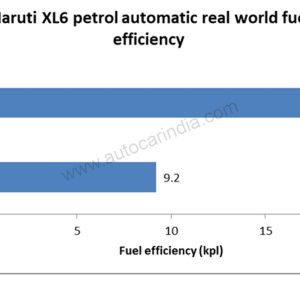
2022 Maruti Suzuki XL6 real world fuel economy tested, explained
Based upon our real-world tests, heres an appearance at the Maruti Suzuki XL6 petrol automateds fuel efficiency figures.Published On Nov 15, 2022 08:00:00 AMThe Maruti Suzuki XL6 is a premium alternative to the popular Ertiga. In its latest avatar, this 6-seater MPV is powered by a brand new 1.5-litre K15C DualJet petrol engine that produces 103hp and 137Nm of torque, and gets a brand-new 6-speed automated transmission. We put it to the test to learn its real-world fuel efficiency.Auto engine stop-start checks fuel intake while idlingSharp throttle responses hinder city fuel efficiencyIn our basic tests, the Maruti XL6 fuel automatic provided 9.20 kpl in the city and a tremendous 17.01 kpl on the highway. These figures are a considerable enhancement over the pre-BS6 1.5-litre K15B petrol-automatic, which returned simply 7kpl and 15kpl in the city and on the highway, respectively.What is the real world efficiency of the Maruti Suzuki XL6?Marutis new K15C engine includes mild-hybrid innovation, which includes automated engine stop-start, brake energy recuperation and torque assist. It also gets dual injectors, double variable valve timing and a greater compression ratio, all in the interest of improving fuel performance. As a result, city fuel performance has actually gone up by a substantial 2.01 kpl over the previous version; however, the XL6s sharp throttle reactions, that make it feel really vivacious in the metropolitan environment, stay one of the key reasons for its single-digit mileage figure.Out on the open roadway, the story is different and the brand-new 6-speed torque converter, which changes the 4-speeder, gives the XL6 longer legs to cruise, lowering fuel usage. For recommendation, at 100kph, the XL6s engine spins at 2,100 rpm in 6th gear, whereas the older 4-speeder travelled at 2,700 rpm in leading gear.Autocar Indias fuel efficiency testingBefore our real-world fuel effectiveness test, we fill the tanks of our test cars to the brim and maintain tire pressures based on the producers recommendation. These cars and trucks are driven in fixed city and highway loops, and we preserve particular average speeds. Throughout our test, there is only one person in each automobile, running the air con and other electricals like the audio system, signs and wipers when required, simply like how routine users would. Regular motorist swaps further neutralise variations in motorist patterns. At the end of each cycle, we determine performance by filling them up to the brim again.Also read:2019 Maruti Suzuki Ertiga review, road test2022 Maruti Suzuki XL6 review: Upping the anteHyundai Creta 1.5-litre petrol CVT real world fuel economy tested, explainedCopyright (c) Autocar India. All rights booked.
Leave a reply